For the sake of meeting up with some friends in India, I ended up getting a flight from Kathmandu and a return to Oz from Delhi.
The original plan was to do go from kolkata to Delhi (aw well .. always next time)
I also figured it would be a bit more of a gentle introduction since, even though I have never been to Nepal, I anticipated that India would be a bit more full on (which, of course, it was).
My route basically looked like this with a few little sojourns on the side.
https://maps.google.com.au/maps?saddr=K ... ,3&t=m&z=7" onclick="window.open(this.href);return false;
Kathmandu of course was crazy (after 2 days couldn't wait to get out - left at 4am to avoid the traffic) but regarding riding serenity , cycling in nepal was definitely the highlight.
Even though there are some phenomenal altitudes, as far as sealed roads go, the gradients are always manageable. Since the trucks tends to carry three times more than what they should, there is no point them making painfully steep roads like you sometimes encounter in Australia.
Due to my previous experiences in India, initially I was a bit apprehensive about taking the highway (or indeed anything called "highway") in Nepal (especially since there is essentially only one road that runs east to west in nepal) but I found it to be very pleasant. The traffic was light, almost like a country road in australia, and aside from a few patches under construction near kathmandu, the road was in excellent condition. Usually the trucks traveled in convoys, with one slow one holding behind maybe 7 others that are eager to pass it through the hilly area. Due to the surreal hilly landscape of nepal, cars don't make a whole lot of sense, so you tend to only find heavy traffic moving north south over the shortest route to the Indian border as opposed to the entire east west stretch. Definitely planning to go back to Nepal. I even got a few KOM records on strava (ok so I am the only one who is recorded for doing the segments).
The worst stretch of road was maybe 60 km of more or less relentless pot hole pannier bag-throwing-off-rack hell into india from nepal at Nepalgunj. I guess the constant heavy traffic over the border quickly destroys whatever gets repaired and an absence of route alternatives to detour traffic while repairing makes such efforts infrequent. It was reminiscent of the mtb paths in nerang forest at the gold coast after being eroded by rain. As a saving grace, the longest best stretch of road I have ever cycled on (in my life) was the yamuna expressway - a toll road (no costs for cyclists) that stretches from agra to delhi. It runs for over 100km and is smooth with a car sized lane for slow traffic that was always empty. I think the high price of the toll road drives away the traffic. The only down side is that it is quite boring, with nothing but agricultural fields either side - practically no settlements ... although people from nearby villages congregate on the side quire regularly to hitch a ride either way. Not much in the way of water or food either (maybe 60km between stops) so it pays to stock up.
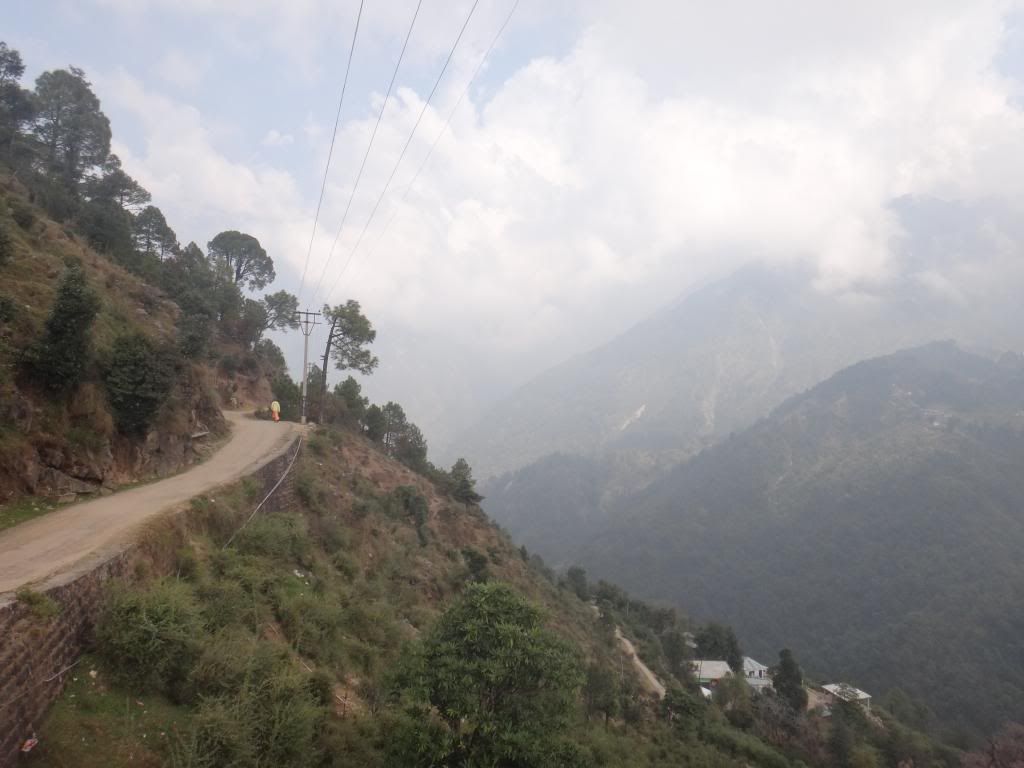
nice smooth hill road in nepal
I found the Nepalese peaceful and friendly and more fluent in english. Due to the language barrier, it was easier to communicate with a Nepalese villager than an Indian policeman. The Nepalese traders were also a lot more straightforward in their business dealings. Finding guest house accommodation in nepal was also easier since in India its complicated by the government having a requirement that all foreigners fill out special forms at the hotels (as a security measure against terrorism) . So in india many budget guest houses will turn you away since they don't have the facilities to meet the government standards . this tends to default you to the top end hotels ... which then poses another sort of delicate problem when you roll up in a dirt encrusted bike.
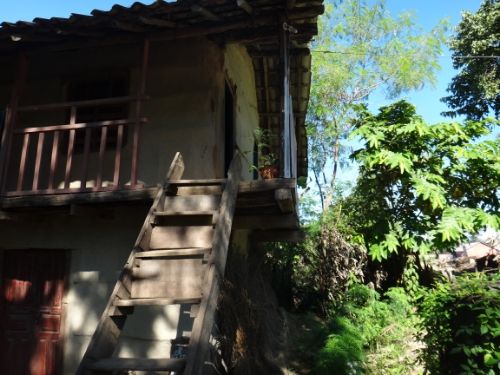
penthouse suite that I stayed at in nepal
In nepal the truck and bus drivers are your number one fans (a poignant contrast to australia) - they hang out and wave you on like a tour de france competitor. I can honestly say I felt more safe in India and Nepal on a bicycle than I do in Australia even though I rode through about 3 heavily built places (including delhi) at peak hour in the early evening (with lights of course) . The traffic is slower and there is so much unpredictable stuff happening, no one in their right mind is inattentive and drives a car like a lemming. Most of the problems come from traffic coming the opposite direction. So if you see a car coming your way overtaking a truck overtaking a camel, its worth your while to steal a glance behind you (or even better, install a mirror on your handlebar and look at that) just to make sure a similar combination isn't also there in the making in your rear. On that note the audibility of horns can be quite deceiving in India. Sometimes a motorcycle will have something that sounds like it heralds the angel of death and sometimes a car will have something that sounds like a midget alien burping. Also because there are so many horns all over the place, its a bit hard to work out who is coming from where.

dog chilling out in the traffic
The indians were also friendly but of a different sort. They wanted to stop you and talk (although it mostly boils down to three questions : what country are you from? Where are you going? How much does your bike cost?). I remember once when I was riding through Lucknow during peak hour traffic and a family man got out of his car (while holding up traffic) so he could shake my hand. Stopping to buy a banana or some water will always draw a crowd .... more so in India. In India I got a lot more invitations to stay at people's houses in than I did in Nepal (although this might also be a consequence of me wearing a dhoti while cycling - traditional indian dress). Sometimes I cooked rice and dhal for them since it was a bit of novelty to eat "bideshi food" I cooked on my matitil (kerosene) camp stove. I even got interviewed by two journalists in India. There were also a few dubious sort of characters you inevitably encountered around cities but trusting one's gut feeling pays off. I also tended to ignore boys and young men who made envious whooting noises like apes when they caught scent of my bicycle. In India the driving public tend to stare at you in a manner that is a bit disconcerting, but if you smile and nod your head they soften up in a manner reminiscent of nepal.
A good travel commodity is Chira (or sometime pronounced chewra). Its flat rice
http://en.wikipedia.org/wiki/Flattened_rice" onclick="window.open(this.href);return false;
You can soak it in 5 minutes with cold water and its ready to eat. For a quick breakfast I would mash it up with bananas. You can also cook it other ways, by making something like stir fried rice with teh soaked grains, or stir frying it dry with oil and spice for something more crunchy.
Towards the end I was getting a bit of a cold due to the onset of winter. A healthy Vitamin c packed fruit is called amla
http://en.wikipedia.org/wiki/Indian_gooseberry" onclick="window.open(this.href);return false;
It tastes a bit sour, almost like a lemon, but you just put one in your mouth and suck on it and it works wonderfully. Also if you drink some water afterwards you get really refreshed.
Sugar cane juice is a real treat for the fatigued and also healthy in a 101 ways that regular sugar isn't. Especially with a bit of lime squeezed in. Vendors commonly have machines that crush the cane with motor powered rollers. They flick another switch and the same motor powers the wheels on the vending machine and they take off down the road at about 15km per hour ...
They also boil the sugar cane juice down to make a block of crude sugar called "gaur" which is used in a variety of simple sweets that are also easily available, such as a peanut brittle thing and also a wafer thing made with amaranth. I always kept some gaur or gaur product handy for a quick energy blast. Sometimes I would buy some hot milk and chapatis and eat them with gaur.
Its also easy to get plenty of deep fried things like samosas from the road sides but this sort of stuff is easy to get sick on so I only ate them sparingly. Apart from the cough and sniffles from the cold weather, I didn't get sick at all.
Of course in India doing epic bike rides isn't big on the national agenda. They find it unthinkable that someone would ride a bike fro such a distance. I talked to a local 17 yr old boy who once rode 500km. He explained that the police at a check points (there are many of them, but they never give foreigners any problems ... in fact they are helpful and sometimes let you rest a bit with them) took a hold of him suspecting foul play (maybe he was on the run from something) and contacted his parents since his side of the story seemed blatantly illegitimate
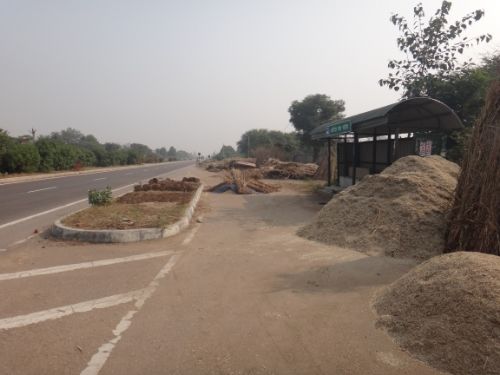
On the road to jaipur, India
I guess on average it worked out at about 50-100km per day, but i stayed in some places for a few days or even a week or two. The longest I did in one day was around 220km. The shortest, 8km.
Sometimes the friendliness of Indians was too much and I stealth camped just so I could avoid the fatigue of it all. Outside the indian cities and built up areas it was easy to find suitable spots. In nepal it was a bit more tricky since villagers, due to walking about mostly on foot in the hills, had the uncanny ability to pop out of anywhere. Usually I would cycle along until it was almost night and then turn off my lights and dip off down a little track from the main drag. The key word here is stealth. If one person finds you, there is a good chance 20 other curious people will come in 10 minutes.
I bathed a lot in public by wrapping a gamcha (like a thin cotton towel) around me. I had a 10 litre folding bucket ($8 from K mart) that I could scoop water up or collect it under a hand pump. Nepal had water coming out from everywhere so it was alot easier. In India I was usually on the look out for "dhabs" - truck stops that sell surprisingly good food and usually have a big tank that you can dip a jug into and scrub down.
Taking bath three times a day was a real treat on the longer rides.
In nepal there was many rivers and streams I would have loved to take bath in and camp near (none of them in Kathmandu) but it was the nature of the landscape that they were mostly at the bottom of gorges (which must turn into raging torrents in the monsoon) and proved too troublesome to manhandle my bike down to
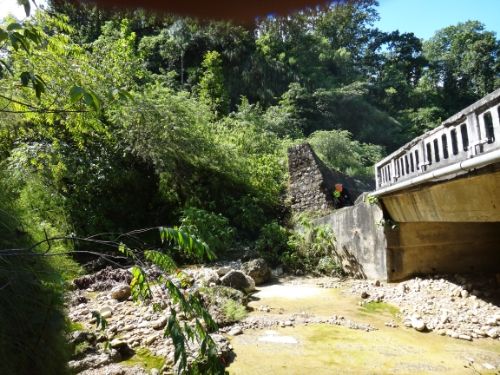
Rest spot at a stream in nepal.
Also of note, geared bicycles, while still somewhat uncommon in nepal (at least outside of kathmandu), they are practically unseen in the parts of india I visited. Even though India is more affluent than nepal, the amount of attention my geared front disc braked bicycle caused sometimes bordered on the ridiculous. Sometimes I would let some village men have a go on my bicycle but because I am a bit tall and the drop bars are totally unfamiliar to them, they found it a bit awkward.
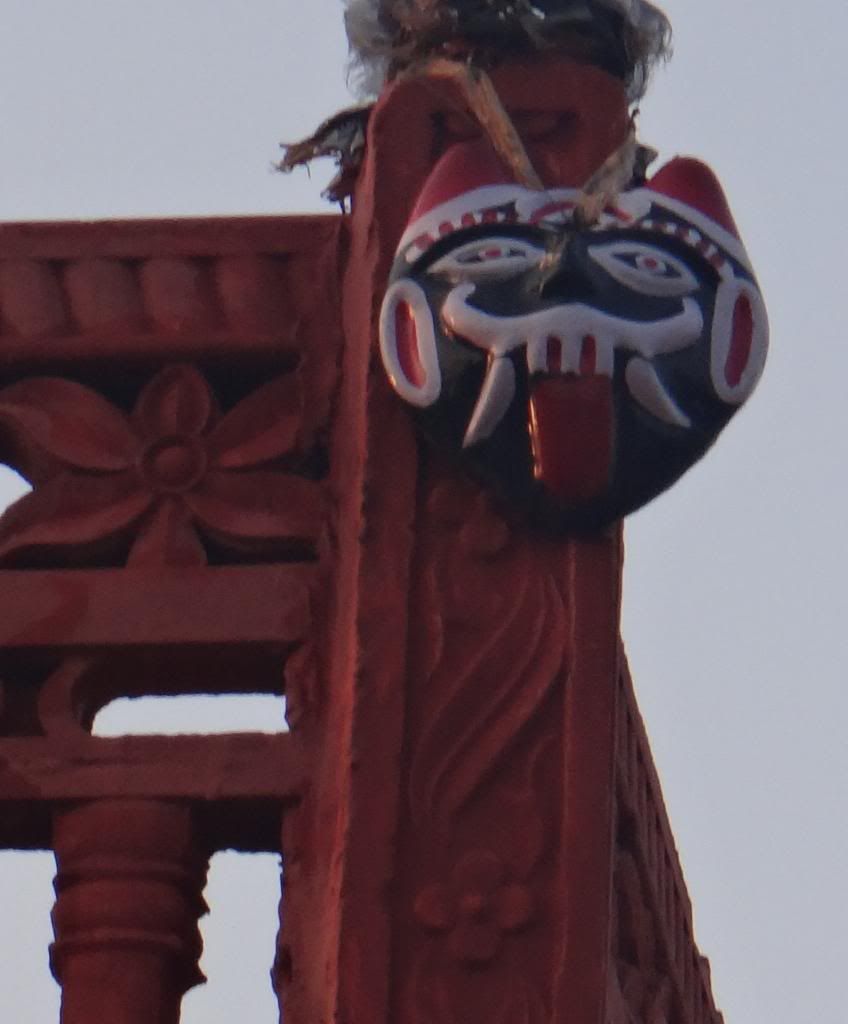
This image turns up a lot on people's houses and the back or cars and trucks. Its meant to avert the evil eye of envy from others. Kind of like if you look at someone's property in a nasty manner, this guy averts it by being more nasty in return. I think it would be a good design for the back of a cycling jersey.
Initially I thought I would chronicle everything for posterity on CGOAB but I didn't have the time or even internet access most of the time .... apologies for rambling
Anyway here are a few bits of equipment that I found useful or notable :
dhb Hi Viz Waterproof Cycle Jacket - it never really rained but towards the end it started to get cold. This jacket has a lot of vents you could gradually unzip as the sun started to warm things up.
Bicycle horn - the old school one where you squeeze the black rubber. A bit hard to quickly access in a fix, but when you come behind someone it certainly carries a bit more bluff than what people commonly attribute to a mere bicycle. While quite common in west bengal (on rickshaws) I didn't see any in UP/Nepal ... so it ended up proving another point of attraction on the bike
India SD card for India for garmin 800 - sometimes it gives kooky suggestions for short cuts through weird village paths which can try your patience when you are in no mood for adventure, but it certainly gives you the confidence to get off the beaten track. Used a K-edge mount. When asked what it was, I just said it was a mobile.
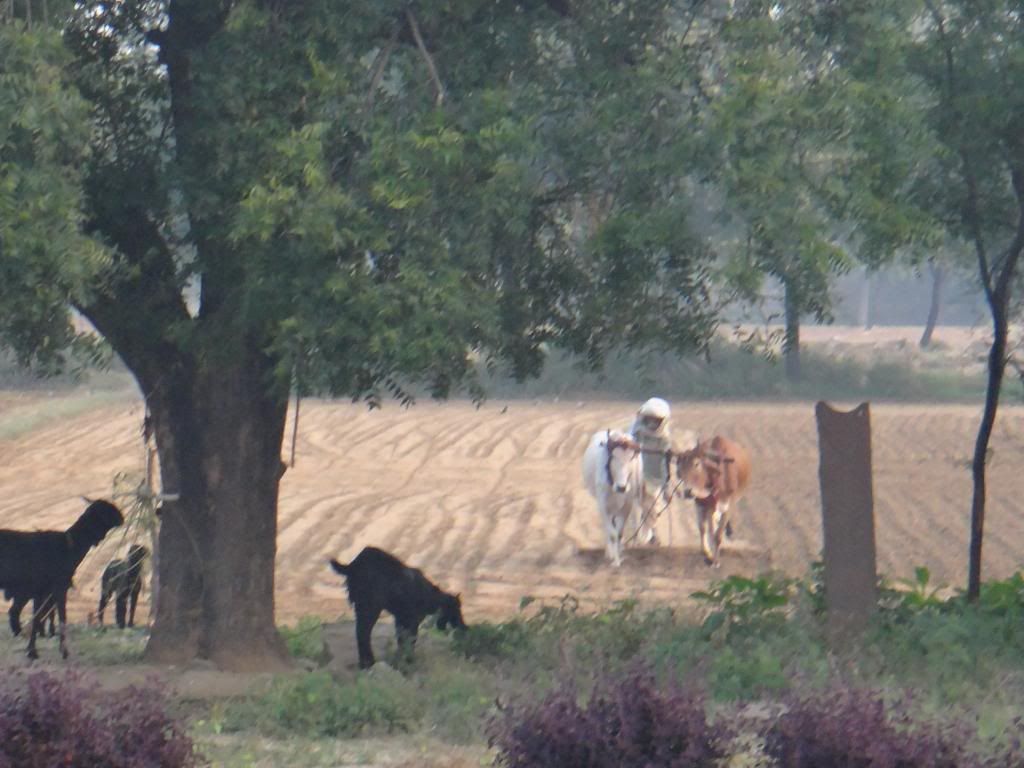
village scene courtesy of garmin - no roads for cars within 10km of here
Solar monkey - to keep the garmin in operating order everyday when there is no power access
Ugly Fish wrap around sunglasses - got the lightly tinted ones so I could keep the dust out of my eyes at all times of the day or night.
Ay-up lights - add another blast of bluff as people mistake you for a motorbike and give you a wider berth in low light conditions.
2" schwalbe marathon tyres - I think I probably could have done the sealed roads of nepal in something thinner, but I was thankful for each mm of tyre width in India.
Neoprene wine bottle covers - water bottles in india/nepal are slightly too small to fit in my cages so this enabled them to be fastened
MSR 3 L bladder - tie it down on the back rack for a back up supply of water for long/uncertain trips and a reservoir for stealth camping.
MSR water filter - used quite a lot in nepal when I was taking water dripping out of the sides of mountains
Tubus elastic straps - to secure rear panniers to the rack after they flew off 2 or 3 times
Rear vision mirrors - since growing eyes in the back of your head is more costly
All up it was a great tour. Planning to go back again and do more in the north side , something like these guys
http://www.masterlyinactivity.com/garhwal/intro.html" onclick="window.open(this.href);return false;







